Waste Diversion
This page includes information to enhance literacy about waste diversion, demonstrate what Notre Dame is doing to mitigate the amount of waste sent to landfills, and inspire ways you can take action.
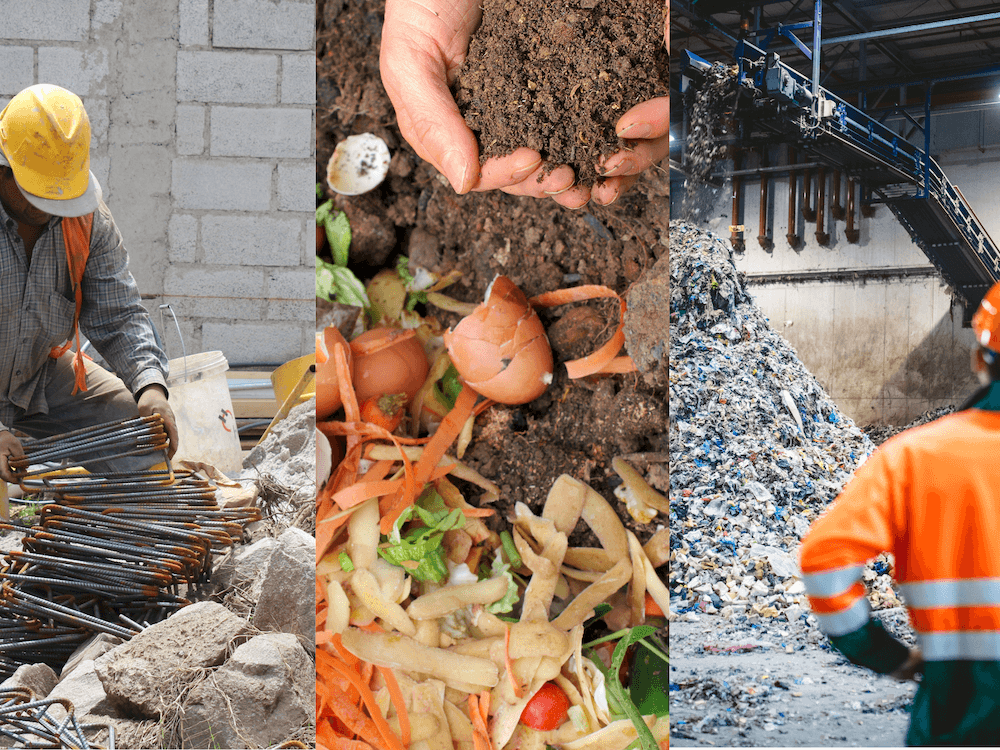
Organic and inorganic materials alike have a lifecycle. At the end of all lifecycles, waste is produced. Yet, how waste is managed varies greatly. Organic items can sometimes be returned to the earth through methods like composting. Inorganic materials may be recycled or repurposed, and others make their way to landfills. Waste generation is a normal part of every human's existence, and it is created from a host of actions. Whether it is individual food preparations or large-scale building and construction projects, waste feels like an unavoidable outcome. Still, many waste diversion efforts can be considered before an item is taken to be landfilled.
The Complex Effects of Waste
Globally, landfilling is one of the most prevalent forms of waste management. The three most common landfill types are municipal solid waste landfills, industrial waste landfills, and hazardous waste landfills. While landfills in the United States typically have specific design requirements to reduce potential environmental effects, poorly managed waste can contribute to greenhouse gas emissions (GHGs), water and soil contamination, air pollution, the spread of infection, and non-communicable diseases.1,2 The environmental effects of waste converge and overlap through many sustainability topics like pollution, water quality, and human health. However, there are other actions that can be taken to mitigate waste from the landfill and reduce environmental effects. One tool that guides Notre Dame's waste mitigation strategies is the Waste Management Hierarchy from the EPA (below).
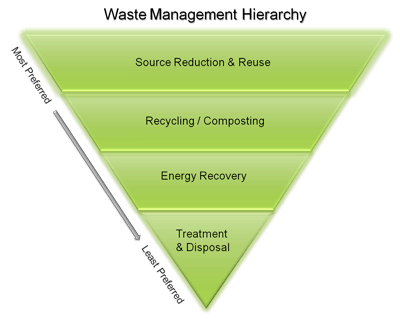
Source: Sustainable Materials Management: Non-Hazardous Materials and Waste Management Hierarchy (EPA).
How Notre Dame Mitigates Campus-Generated Waste
When possible, the University pursues ways to avoid landfilling and participate in materials recovery. Below is a sample of what Notre Dame is doing to mitigate its waste streams.
Source Reduction & Reuse
Surplus Property Program
Before an item is sent to the landfill, it is expected that all surplus University assets will be processed through Notre Dame’s Surplus Property Program in a timely manner and that all University departments will consider reusing quality surplus items prior to considering the purchase of new items. Notre Dame faculty, staff, students, and members of the local community are able to shop for used items such as furniture, computers, office supplies, lamps, and more. Items are reasonably priced to ensure access to purchasing these second-hand goods, promoting a circular economy.
Grotto Candle Reuse Program
Every year, approximately 250,000 candles are burned at the Grotto. Because glass with wax residue cannot be recycled through single-stream, Notre Dame sends the jars to Quality Compound Manufacturing, which buys scrap wax for industrial use. This allows the clean jars to then be used by the University's candle supplier. This process keeps a quarter of a million candle jars out of the landfill annually.
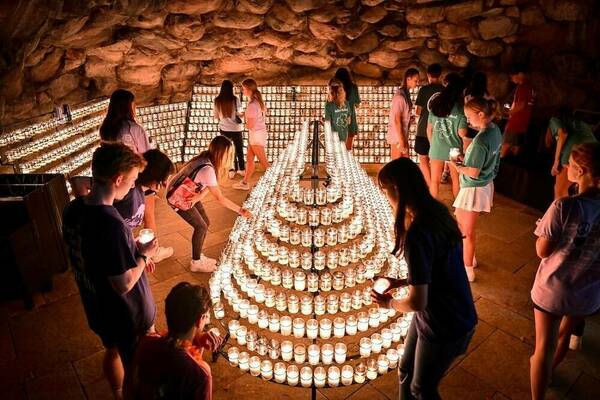
Grind2Energy
The Grind2Energy program tackles the issue of post-consumer food waste and food preparation scraps in the North and South Dining Halls, as well as the Center for Culinary Excellence. Organic food waste is collected, ground down into a slurry, and transported to a local farm, Homestead Dairy. From there, the byproducts of the slurry are used as nutrient-rich fertilizers, biogas for the farm, and bedding for livestock. This program has been paramount in reducing the amount of food waste that would otherwise be sent to the landfill. Notre Dame was the 2nd university in the United States to invest in this type of program.
See our Food resource page to learn about the other ways Notre Dame prevents and mitigates food waste.
Habitat for Humanity ReStore
Habitat for Humanity ReStore is a home improvement store that sells donated new and gently used furniture, appliances, home goods, and building materials. The benefits of Habitat ReStore are two-fold, by creating accessibility to materials through affordable pricing and funding Habitat for Humanity homes through the ReStore sales. When the University vacates spaces, Habitat ReStore will come to collect viable materials, from traditional furnishings like couches, desks, waste bins, and lamps to functional finishes like stair hand railings, baby changing stations, outlet covers, and exit signs. All collected items are available to the public at ReStore for a fraction of retail prices.
Recycling & Composting
Diverting Construction Waste
Our Facilities, Design, and Operations team works tirelessly to reduce construction waste as campus continues to update and expand. For construction projects such as the Duncan Student Center, Corbett Family Hall, O’Neill Hall of Music, Corby Hall, and the Irish Athletics Center, Notre Dame was able to divert 4,785.94 tons of waste—only contributing 447.92 tons to the landfill—that’s a 91.44% diversion rate.
Paper Shred Events
Notre Dame hosts an annual shred event, inviting University affiliates to bring their personal files to be shredded and recycled for free with the company, Shred-It. In 2023, the event diverted 2,440 pounds of paper from entering the landfill.
Residence Hall Move-Out
Tons of waste can accumulate after a year of living in one space. To ensure that unwanted or unused items continue their full lifecycle, Building Services works tirelessly each move-out season to manage waste and deploy collection stations throughout campus. Donations are collected and sent to Goodwill Industries of Michiana. For the first time in 2022, carts were set up inside residence halls to collect smaller items. This process continues today, with donated items consistently filling carts to capacity! Previously, all materials were stacked on the lawns in front of residence halls and subject to varying weather conditions. Other material accumulations like single-stream recycling or cardboard are collected in recycling toters and large containers.
Everyday Recycling
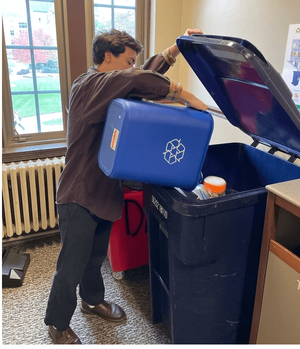
The University pays for single-stream recycling services through Recycling Works. Single-stream recycling refers to a process in which multiple recyclable materials are collected in one container that is later sorted at a facility. The program works just like any municipal program at home: individuals collect their recyclable materials in a personal bin, and once full, personal bins are emptied in a centrally located recycling toter. Each Tuesday night/Wednesday morning, Notre Dame’s custodial staff roll full toters out to the curb to be picked up and taken to a recycling facility.
Cardboard is also a common everyday recyclable. While it is accepted through the single-stream toter system, cardboard typically takes up too much space in toters, disallowing the collection of other materials such as bottles or cans. Instead, gray cardboard carts are located throughout campus to collect flattened cardboard that is later baled for collection. The graphic below demonstrates single-stream and cardboard recycling that has been diverted since August 2023.
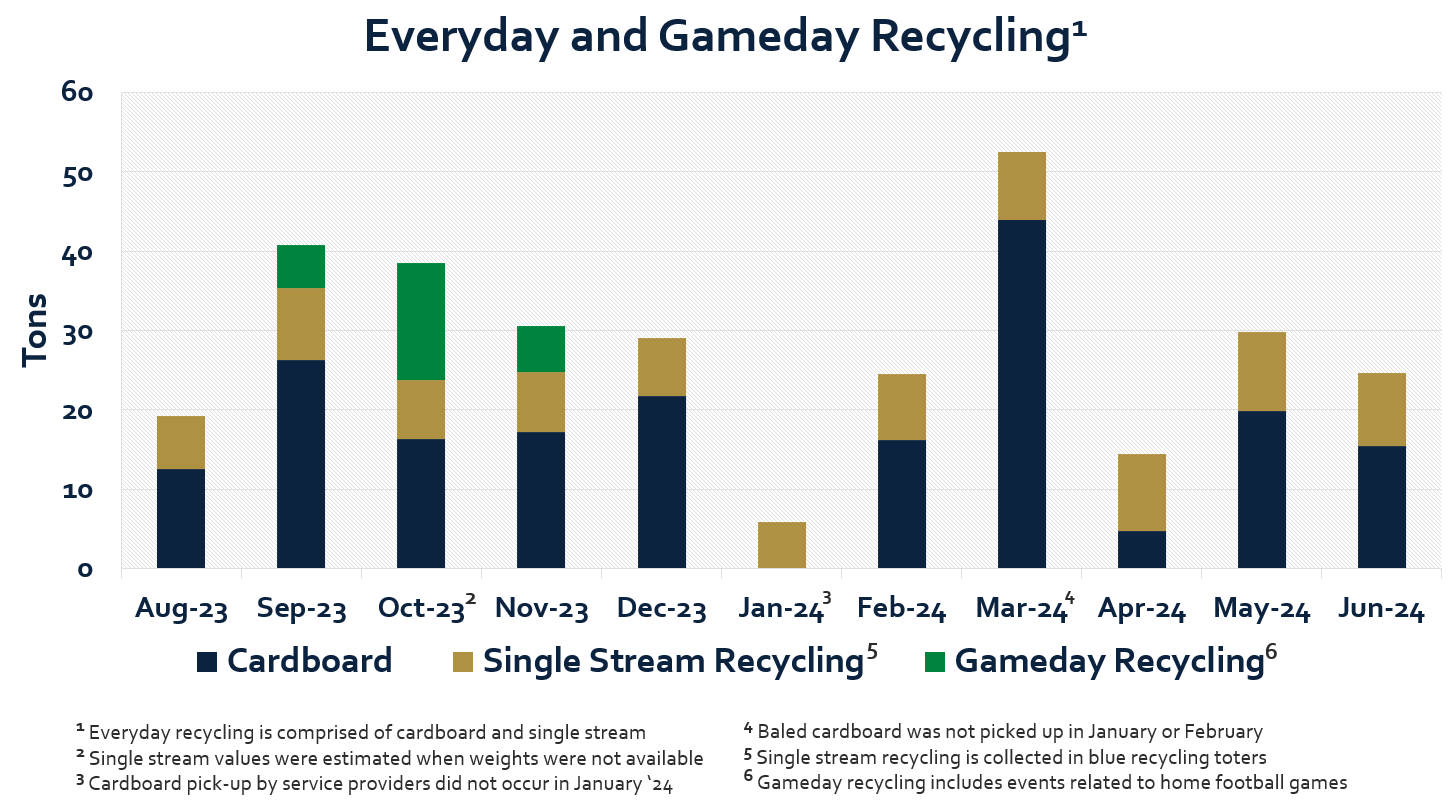
Specialty Recycling Programs
While materials like plastic and glass bottles, aluminum cans, and cardboard are recycled through the single-stream service, some items must be disposed of through alternative means. University-owned electronics and appliances that cannot be refurbished for the Surplus program are sent off to be properly recycled.
How You Can Take Action to Mitigate Waste From the Landfill
Reducing waste is a key attribute of a sustainable lifestyle. The average person contributes 4.9 pounds of waste per day, and only 32.1% of waste is recycled or composted. In fact, Michigan and Indiana had the most trash in landfills per capita in the United States in 2022.3 Choose to properly divert your waste to ensure that it does not contribute to landfills.
Avoid
Bring your own reusables
Many single-use items have a reusable counterpart. With a little bit of planning, you can make a big impact to help divert waste from the landfill. Consider carrying a reusable water bottle, shopping & produce bags, straws, and cutlery. If you know you’re going out to eat and may have leftovers after your meal, bring a collapsible food storage container to take your leftovers home!
On campus, reusable cups and mugs are allowed for self-service coffee and tea in the Dining Halls, Au Bon Pain, Common Grounds, Crossings, Garbanzo, and Decio Cafe.
Consider whether or not you really need it
It’s easy to get swept up in the excitement of buying something new. But, before you purchase something, ask yourself: Do I really need this item? If the item in question is something you need, consider finding a used version, or patronizing businesses that have certifications like B Corp or Fair Trade.
Reuse & Reduce
Repurpose
If possible, try to repurpose your waste to fulfill another function. Finish a candle? Reuse the jar for saving small items. Given plastic or paper bags at the grocery store? Reuse the bags for smaller trash liners. There are unlimited ways to reuse, and ultimately, reduce the amount of waste that goes to the landfill. Search for creative reuse ideas on social media to become inspired with ways to repurpose old materials.
Find a Local Repair Shop
When beloved items like shoes or clothes tear, avoid the automatic assumption to toss them in the trash. The Michiana area has many repair shops with talented staff who are ready to breathe new life into your belongings. A quick Google search will reveal local businesses that are ready to handle your next repair. Repairing an item versus buying a replacement can save you money and keep items from going to the landfill.
Recycle
Single-Stream
Familiarize yourself with on- and off-campus recycling resources to learn what can and cannot be recycled, and proper recycling protocols. Check out the A-Z Recycling Directory to find out what to do with your materials. Sustainability and Building Services continue to work diligently to streamline the recycling process on campus. If you live off campus, learn more about St. Joseph County's Curbside Pick-Up program, as well as other County recycling options.
Specialty Recycling
Sometimes, you don't have a choice if products like styrofoam or plastic packaging are used in the goods you purchase. While these can't be recycled through single-stream services, you can take them to a specialty recycling center to be repurposed. See our community resources page for more information on local recycling centers.
Donate Old Items and Thrift New Finds
Maybe a sweater you loved two winters ago is no longer your style, or you've remodeled your home and have an old kitchen sink in good condition with more life left. There are a host of different types of donation services and thrift stores in the Michiana area, including Resale to the Rescue, Goodwill, Salvation Army, and Habitat for Humanity.
Thrifting is an easy way to reduce your carbon impact. Americans throw away 13 million tons of clothing each year and the fashion industry contributes about 10% of global carbon emissions—as much as the entire European Union.4,5 By choosing to engage with second-hand stores—whether it be purchasing from, donating to, or selling to—you are working to reduce waste and carbon emissions.
Assess Your Waste Impact
For one week, challenge yourself to save all of your waste in one space like a zip lock bag to carry with you throughout your day. Analyze what you're generating and consider whether or not this waste can be avoided.
Sustainability & Waste Across the University
Engineers unmask nanoplastics in cceans for the first time
Sources:
- Siddiqua, A. et al.; Environmental and public health effects of landfills. National Institute of Health, 2022.
- N.a., Solid waste management. United Nations Environment Programme, n.d.
- N.a., Most trash in landfills per capita in the United States in 2022, Statista, 2022.
- Beall, A., Why clothes are so hard to recycle. BBC News, 2020.
- Maiti, R., Fast fashion and its environmental impact. Earth.org, 2024.